| Pages:
1
..
15
16
17
18
19
..
33 |
nitro-genes
International Hazard
    
Posts: 1048
Registered: 5-4-2005
Member Is Offline
|
|
Like the new topic name!  Supergeil! Supergeil!
https://www.youtube.com/watch?v=jxVcgDMBU94
|
|
|
dave321
Harmless

Posts: 45
Registered: 22-11-2012
Member Is Offline
Mood: No Mood
|
|
Quote: Originally posted by Hennig Brand  | Well I have what I hope is iso-picramic acid. It has been drying for the last day or so, so I will include a picture of the dry yield and attempt to
make some iso-DDNP using it.
Extraction of Paracetamol (acetaminophen)
Forty extra strength 500mg Tylenol tablets were put into a Mason jar and an amount of methanol was added which was at least the height of the pills
over and above the pills (very scientific measurement  ). An oval stir bar was
added and the mixture was stirred using magnetic stirring at room temperature until dissolution and erosion caused the pills to break up. The stirring
was ceased and the mixture allowed to settle for several hours before pipetting off the clear paracetamol in methanol upper layer. More methanol was
added to the pill residue and it was again stirred up and left to settle before removing more solution. This could have been done at least once more,
but it wasn't. The combined methanol solution was next heated, below the boil with stirring, until most of the methanol was gone before adding 30-40mL
of cold water (the remaining methanol could have easily been evaporated, but the water may have served a function over and above reducing solubility,
it may have dissolved some of the trace amounts of water soluble impurities from the pills which made it through the extraction. ). An oval stir bar was
added and the mixture was stirred using magnetic stirring at room temperature until dissolution and erosion caused the pills to break up. The stirring
was ceased and the mixture allowed to settle for several hours before pipetting off the clear paracetamol in methanol upper layer. More methanol was
added to the pill residue and it was again stirred up and left to settle before removing more solution. This could have been done at least once more,
but it wasn't. The combined methanol solution was next heated, below the boil with stirring, until most of the methanol was gone before adding 30-40mL
of cold water (the remaining methanol could have easily been evaporated, but the water may have served a function over and above reducing solubility,
it may have dissolved some of the trace amounts of water soluble impurities from the pills which made it through the extraction.
Dinitration of Acetaminophenol
Nitro-Genes posts were used as a general guide. The following numbers were used which were suggested by Rosco:
"
[A] For each 1 gram of paracetamol to be dinitrated, dissolve in 4 ml H2SO4
[B] For each gram of paracetamol to be dinitrated, use 1.4 gram of NH4NO3 mixed with 1.5 ml H2SO4
Add gradually with stirring B to A maintaining about 5C
The quench / dilution mixture should have about 15 grams ice for each gram of paracetamol.
It would possibly benefit the nitration mixture to sit for a couple of hours in the ice bath with continued stirring before quenching."
I used the following method because I was lazy, busy and very low on ice. 14.4g of paracetamol was started with and 91% sulfuric acid was used
throughout. The powdered paracetamol was added to the sulfuric acid in a Mason jar in about six increments with swirling and in between additions the
solution was cooled down in the fridge. The ammonium nitrate (fertilizer grade recrystallized from water) was added to sulfuric acid in another Mason
jar and left to dissolve over night in the dark at room temperature. The paracetamol in sulfuric acid was kept in the fridge while the nitration
mixture was not, though they both probably could have been. A large oval stirrbar was added to the vessel holding the solution of paracetomol in
sulfuric acid. When making an addition about 3-5mL of the nitration mixture was added with swirling before placing the mixture back into the fridge to
cool. Starting the nitration in the morning I made additions randomly, about once an hour. By early afternoon the additions were complete. It wasn't
until the next morning that the nitration mixture was removed from the fridge and quenched with crushed ice and filtered and rinsed with water.
De-acetylation to Iso-Picramic Acid
About 15mL of 91% sulfuric acid and 15mL of water were mixed and added to the still damp dinitro acetaminophenol in a beaker with stirrbar. The
temperature was raised gradually and at about 70C the smell of acetic acid was very noticeable and by 80C the fumes were very strong, almost choking.
After about 45 minutes and with the temperature at 100-105C no more smell of acetic acid could be detected. The color change from light to dark
occurred mostly in the first 10 minutes or so of heating. About 80mL of water was then added. Filtration was attempted but was then aborted, as a
test, but also because not everything was in solution (does it matter?). The amount of acid and water used was likely not ideal.
The solution was next allowed to cool and then household ammonia was pipetted in with stirring unit the color change to red became apparent and then a
couple drops of 31.45% HCl was added to bring the pH back down slightly (I was going to use sulfuric acid, but the HCl was much closer to me at the
time and it was just a couple of drops). The reddish brown iso-picramic acid was easily gravity filtered. The yield is now nearly dry. I will post a
picture of the dry yield soon and will attempt diazotisation to iso-DDNP. There were many transfer losses, etc, so the yield may not be great.
[Edited on 16-6-2015 by Hennig Brand] |
hennig / rosco ,
what do you think would be a reasonable ratio / amounts to use if you were doing the nitration using 98%sulphuric and 70%nitric mixed acids? per gram
of paracetamol
interesting thread as it seems this procedure to use paracetamol may be a better route than the conventional one using picric acid, the para isomer
seems a very promising material from what I have read.
my primary interest is for use in bullet hits for spfx.....commercial lead free ones use ddnp
|
|
|
nitro-genes
International Hazard
    
Posts: 1048
Registered: 5-4-2005
Member Is Offline
|
|
IMO, good place to start would be dissolving 1 g of acetaminophen in 5 g 98% H2SO4, adding a mix of 1.257 g of 70% nitric and 1.4 g 98% sulfuric at 0
deg C.
|
|
|
Hennig Brand
International Hazard
    
Posts: 1284
Registered: 7-6-2009
Member Is Offline
Mood: No Mood
|
|
Nitro-Genes has more experience with this reaction so I would listen to him. I would probably tend to use a little bit more of an excess of nitric
acid, but what he has suggested is probably enough if everything is of the correct concentration and purity and measured accurately.
I see that what I used was about a 32% excess of nitrate, which doesn't seem to have hurt much except economics. Nitro-Genes has just suggested about
a 6% excess which is probably good. I would probably use 10% normally, but really it would mostly be because of preference and a little experience I
guess.
Using the large excess of nitration mixture was designed to test whether the paracetamol could be nitrated farther and if there were any other
reactions that could happen when trying to push the nitration farther. It appears that there isn't any complications at this point.
[Edited on 17-6-2015 by Hennig Brand]
"A risk-free world is a very dull world, one from which we are apt to learn little of consequence." -Geerat Vermeij
|
|
|
Rosco Bodine
Banned
Posts: 6370
Registered: 29-9-2004
Member Is Offline
Mood: analytical
|
|
I plotted all the reported nitration mixtures and water contents and solids content and sort of interpolated the ratios suggested in a U2U making an
educated guess about the use of the solid nitrate with sulfuric acid which is still within the range reported useful.
If you wanted to replicate using 98% H2SO4 what Hennig has done this was what I shared further about that in U2U with Hennig
| Quote: |
If you are using lab grade concentrated H2SO4, I think it is possible you could even add 0.3 to 0.5 ml H2O per gram of paracetamol maybe even double
that amount and still be okay IMO. It is about the amount of H2O which would result in a saturated warm solution for the amount of NH4NO3 to be used
as about a 70% to 80% solution which would make blending it with the H2SO4 trivial, just set a drip on the H2SO4 and add from a funnel to the NH4NO3
solution.
There are a couple of things that are an advantage, for this synthesis is a dinitration of something easily nitrated at low temperature, and it isn't
a dinitration that will go further to a trinitration which would result in a mixed product. You should get only one main product, not difficult to
isolate. A vulnerability to oxidation exists so time and cooling temperature will be factors controlling that. |
It should be noted that a nitrating mixture having a soluble acid sulfate byproduct should not be considered to provide free nitric acid for
calculation of what is excess "available" nitric acid, because that is an equilibrium mixture where the reaction does not just proceed fully to the
right to provide in actuality the theoretical amount of HNO3 that a linear reaction may suggest. The substrate being nitrated has to take up nitric
acid as it is being nitrated to cause the equilibrium to shift and allow more nitric acid to become available. So in a sense the nitration is self
regulating more and more towards the end of the dinitration, which explains why the reaction moderates towards completion of the dinitration. What
you may think is excess may actually be required to drive the dinitration to completion, because less HNO3 is actually available due to the shift in
the equilibrium of the reaction producing the HNO3.
The lower the temperature the greater will be the effect, so the colder the dinitration mixture, the larger the excess of available HNO3 will be
needed to drive the dinitration reaction to completion.
[Edited on 6/17/2015 by Rosco Bodine]
|
|
|
Hennig Brand
International Hazard
    
Posts: 1284
Registered: 7-6-2009
Member Is Offline
Mood: No Mood
|
|
p-DDNP Synthesis
The preliminary dry yield of iso-picramic acid was only about 9.1g, which is very low. There were large transfer losses but nothing to explain such a
low yield. Luckily, I didn't throw out the reaction mixture from after the de-acetylation. Upon adding 2-2.5mL of 31.45% HCl a good deal more
iso-picramic acid precipitated amounting to an estimated at least two or three more grams (it isn't dry yet). This is one time I should have actually
checked the pH. I also noticed that the reddish color of the iso-picramic acid seems to have faded in the last 20 or more hours while drying.
On examining the now only slightly damp recovered iso-picramic acid it is less than first thought (ca. 1-2g). I did hear faint fizzing coming from the
solution several different times over the last 24 hours. Since the pH was not adjusted correctly a lot of the iso-picramic acid was left in solution
and because the pH was so high a lot of it decomposed (I think). It was obvious that something was wrong yesterday when the volume of iso-picramic
acid obtained was so much less than the volume of dinitro acetaminophenol obtained from the nitration.
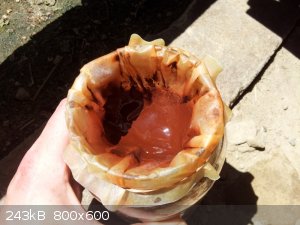
Diazotization
The method from COPAE was used for the diazotization and went very smoothly. The 9.1g of iso-picramic acid was diazotized. Here are a few pictures of
the iso-picramic acid and the produced iso-DDNP.
iso-picramic acid
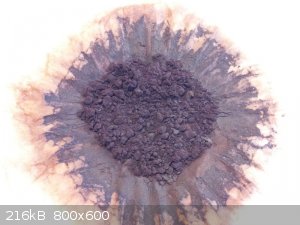 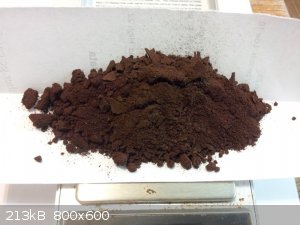 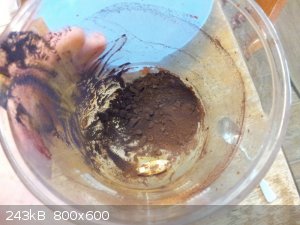
iso-DDNP
The iso-DDNP was put in the sun just long enough to take a picture.
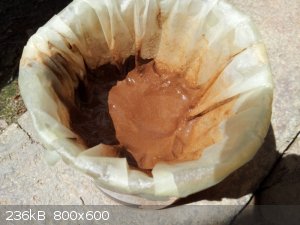 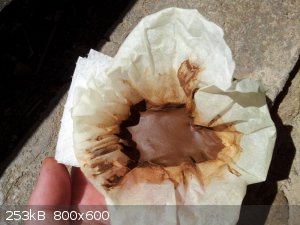
[Edited on 17-6-2015 by Hennig Brand]
"A risk-free world is a very dull world, one from which we are apt to learn little of consequence." -Geerat Vermeij
|
|
|
Rosco Bodine
Banned
Posts: 6370
Registered: 29-9-2004
Member Is Offline
Mood: analytical
|
|
You and nitro-genes can see better what you have encountered while actually doing the reactions hands on, so whatever adjustments to tweak the process
are your discretion. Unless the patent descriptions are misleading there are refinements that should get the yield for the dinitration into the 90%
range.
Given molar weights: paracetamol 151.16 and acetylisopicramic acid 241.16 and isopicramic acid 199.12 and p-DDNP 210.11
100% of theory would provide 1.595 grams acetylisopicramic acid from each 1 gram of paracetamol dinitrated, and deacetylation should provide 1.317
grams of isopicramic acid, and 1.39 grams p-DDNP as the end product result, absent any losses.
No losses would have produced 18.96 grams isopicramic acid as 100% of theory from your 14.4 grams of paracetamol, so 9.1 grams is about 48%. If
another 3 grams was recovered, then the combined yield would be about 64%.
[Edited on 6/17/2015 by Rosco Bodine]
|
|
|
Hennig Brand
International Hazard
    
Posts: 1284
Registered: 7-6-2009
Member Is Offline
Mood: No Mood
|
|
Wow, so I only obtained about a 48% yield of iso-picramic acid, not including the extra recovered. Not exactly a stellar performance. I think I at
least have enough iso-DDNP to do some testing, but my process needs work. I am fairly sure the major yield killer was after the de-acetylation when
adding base and trying to precipitate the iso-picramic acid.
"A risk-free world is a very dull world, one from which we are apt to learn little of consequence." -Geerat Vermeij
|
|
|
Rosco Bodine
Banned
Posts: 6370
Registered: 29-9-2004
Member Is Offline
Mood: analytical
|
|
Yeah I saw that one coming. Don't worry about solubility losses too much for isopicramic acid, as the solubility is so low for the free acid. As for
the pH, well since it is a pH indicator dye in itself, it will tell you what it is doing so long as everything is in solution, the transitions should
be sharp and unambiguous. The supernatant liquid will likely be very pale tint colored because it will have virtually nothing in it after the
titration to precipitate the free isopicramic acid. That is the point where the dye effect is minimized.
I think there may have been loss in the deacetylation step itself from not enough dilution, too pasty a mixture. At the completion of the
deacetylation and dilution there should be no solids in the mixture, everyhting in solution, and what isn't in solution is unwanted byproducts or
unreacted dinitroparacetamol which failed to deacetylate. I think I wondered about the deacetylation when I first saw the picture it looked like
maybe less 50/50 (by volume) H2SO4/H2O was used than needed and maybe nitro-genes used more, maybe more than twice more, I'll have to check to make
sure.
[Edited on 6/17/2015 by Rosco Bodine]
|
|
|
Hennig Brand
International Hazard
    
Posts: 1284
Registered: 7-6-2009
Member Is Offline
Mood: No Mood
|
|
The filtrate was not clear at all and very dark after collecting the first crop of iso-picramic acid yesterday. After adding the 2-2.5mL of acid today
and filtering again the solution is now a much lighter reddish color and is translucent.
Yeah, the amount of sulfuric acid used was decided on somewhat ambiguously as a test and was probably not really right. The complete color change
from yellow-orange to the brown color during the de-acetylation and the cessation of acetic acid production indicated to me that it had completed, eve
though not all was in solution by the end, but if what you say about the solubility is true I may have to rethink that.
[Edited on 17-6-2015 by Hennig Brand]
"A risk-free world is a very dull world, one from which we are apt to learn little of consequence." -Geerat Vermeij
|
|
|
Rosco Bodine
Banned
Posts: 6370
Registered: 29-9-2004
Member Is Offline
Mood: analytical
|
|
You need to follow nitro-genes on that one, and maybe say the Shepards prayer  (Alan Shepard)
(Alan Shepard)
http://www.urbandictionary.com/define.php?term=Astronaut%27s...
It was 5ml of a 50/50 by volume mix of H2SO4/H2O per gram of paracetamol that was dinitrated, which nitro-genes used for the deacetylation.
Really after the deacetylation you could probably dilute to a liter volume with distilled H2O and the soluble isopicramic acid sulfate should remain
in solution for filtering and it may not even need filtering unless there is undissolved material or is so opaque you cant even see through it to tell
if everything is in solution. Likewise using a base to titrate, it would be no issue using a dilute solution. You won't have much loss for any
isopicramic acid remaining in solution because it is such low solubility nearly all of it down to a few milligrams will drop out of solution.
[Edited on 6/17/2015 by Rosco Bodine]
|
|
|
Hennig Brand
International Hazard
    
Posts: 1284
Registered: 7-6-2009
Member Is Offline
Mood: No Mood
|
|
Hey, almost a 50% yield isn't bad for a first try. A couple more attempts I might just get it up to 70 or 80% even. 
God knows what kind of product I actually have then. A bit of burn & explosive testing will be interesting once it dries.
"A risk-free world is a very dull world, one from which we are apt to learn little of consequence." -Geerat Vermeij
|
|
|
Rosco Bodine
Banned
Posts: 6370
Registered: 29-9-2004
Member Is Offline
Mood: analytical
|
|
With all the excess nitrate you probably made the 2,3,5,6,-tetranitro derivative  so this could get interesting.
so this could get interesting.
|
|
|
Hennig Brand
International Hazard
    
Posts: 1284
Registered: 7-6-2009
Member Is Offline
Mood: No Mood
|
|
Ok, here is something Nitro-Genes said on the last page which could explain what was going on during/after the de-acetylation:
Quote: Originally posted by nitro-genes  |
Btw, you were right not do the filtration after the deacetylation, like you said, the water acid ratio was too high, causing dissociation of some of
the isopicramic sulfate to the free acid. Further depends on the temperature, but adding about an equal volume of dH2O to the 50% H2SO4 after
deacetylation is about the maximum that can be added without causing precipiation of the free acid.
|
"A risk-free world is a very dull world, one from which we are apt to learn little of consequence." -Geerat Vermeij
|
|
|
Rosco Bodine
Banned
Posts: 6370
Registered: 29-9-2004
Member Is Offline
Mood: analytical
|
|
Yeah I read that but it is not certain that is accurate. Check the spot test described in the Chemical World article by Meldola. Hang on I'll
attach it here again.
We had discussion about an idea to diazotize the soluble isopicramic acid sulfate from the greatly diluted deacetylation mixture without even
bothering to isolate the free isopicramic acid. And there was a conversion of the free isopicramic acid back to the soluble sulfate, a dilution and
diazotization done as a test which was successful. So I don't know if nitro-genes observed some dissociation for the soluble sulfate in that
experiment, or where is basis for that information.
Another thing worth checking is if it is possible that the hydrolysis is complete after maybe 10 minutes at 85C and that a more dilute H2SO4 like
battery electrolyte would work fine if you want to save your more concentrated acid for other use.
The acetic acid byproduct may present no complication in subsequent manipulation so it possibly isn't really necessary to use long time period or high
heat to complete the deacetylation.
Attachment: Pages from The_Chemical_world pg327.pdf (247kB)
This file has been downloaded 539 times
[Edited on 6/18/2015 by Rosco Bodine]
|
|
|
Hennig Brand
International Hazard
    
Posts: 1284
Registered: 7-6-2009
Member Is Offline
Mood: No Mood
|
|
I suspect Nitro-Genes may be right. Haven't found the pKa for iso-picramic acid, but the concept is the same as for picramic acid.
The following came from a document regarding sodium picramate hair dye:
"
Submission III was submitted in July 2005 by COLIPA and concerned sodium picramate
(CAS 831-52-7). According to this submission, sodium picramate and picramic acid are used
in hair colouring formulations. As the pKa of picramic acid is around 4, it is always the
picramate which is available in typical hair dye formulation (pH 6.5 – pH 10). Therefore the
submission discussed mainly sodium picramate."
If the pKa of the acid salt iso-picramic acid sulfate is very low it is conceivable that iso-picramic acid could start to precipitate if the sulfuric
acid is diluted too much. I would like to know the pKa of iso-picramic acid sulfate.
"A risk-free world is a very dull world, one from which we are apt to learn little of consequence." -Geerat Vermeij
|
|
|
Rosco Bodine
Banned
Posts: 6370
Registered: 29-9-2004
Member Is Offline
Mood: analytical
|
|
It is easy enough to test. Put a weighed amount of dry isopicramic acid into solution using the minimum amount of sulfuric acid needed to form the
sulfate, and note the amount of H2SO4 needed. Then do a very gradual dilution by increments until cloudiness or precipitation appears and calculate
the stable versus unstable concentration, the quantity of H2O needed to see a decomposition of the soluble sulfate to the insoluble free isopicramic
acid.
|
|
|
Hennig Brand
International Hazard
    
Posts: 1284
Registered: 7-6-2009
Member Is Offline
Mood: No Mood
|
|
That would work though it is 1000 times harder than if someone told me what the pKa is, but still pretty easy you are right. I might try that.
"A risk-free world is a very dull world, one from which we are apt to learn little of consequence." -Geerat Vermeij
|
|
|
Rosco Bodine
Banned
Posts: 6370
Registered: 29-9-2004
Member Is Offline
Mood: analytical
|
|
Here is the link from when nitro-genes was experimenting with this
http://www.sciencemadness.org/talk/viewthread.php?tid=439&am...
An above 6.5 pH being achieved at any reasonable dilution is unlikely to occur. Maybe it requires a really extreme low pH to keep the isopicramic
sulfate associated and soluble . Dilution with dilute acetic acid would be less likely to cause dissociation and even if it did the isopicramic acid
would tend to remain in solution up to a point anyway because of the enhanced solubility in acetic acid.
Attached is a data sheet for isopicramic acid but the melting point is incorrect, actual is 170C dec, so I don't know if the other data is good
either. The pink pH 4.0 to yellow pH 5.6 color shift range could be a marker for the dissociation of the sulfate. pKa is reported as 5.09
I think the color transition as incorrectly described on this data sheet is actually the reverse of the color shift described by Meldola, with the
more alkaline range being pink and the more acid shifting to yellow. So this data sheet certainly has errata. Don't pay 200 bucks for an engineering
reference book that has this kind of data error.
The data page (Sabnis) is from Sigma-Aldrich (and CRC) and has an incorrect mp  WTF!
WTF!
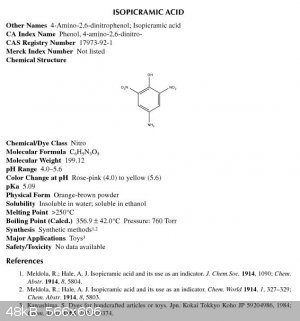
[Edited on 6/18/2015 by Rosco Bodine]
|
|
|
Hennig Brand
International Hazard
    
Posts: 1284
Registered: 7-6-2009
Member Is Offline
Mood: No Mood
|
|
That data sheet doesn't inspire a lot of confidence does it. It is definitely more of a yellow/brown at low pH and then when enough base is added it
goes a pink/reddish color.
"A risk-free world is a very dull world, one from which we are apt to learn little of consequence." -Geerat Vermeij
|
|
|
nitro-genes
International Hazard
    
Posts: 1048
Registered: 5-4-2005
Member Is Offline
|
|
The purplisch colour is from the ammonium isopicramate. I know because I tried to recrystallize the ammonium salt to obtain very pure isopicramic
once. It forms beautiful purple crystals with a green/gold lustre when dry, I suspect it is a hydrate. Likely, your iso-picramic is brown due to
presence of the ammonium salt from over neutralizing, which could also trouble the diazotization. I have been busy and not updated this into the rough
synthesis posted earlier, but during neutralization of the isopicramic sulfate it is better to aim for a pH of around 4, like I U2Ud you.  I used test strips for that, since I don't have a pH meter. I used test strips for that, since I don't have a pH meter.
Here is a daylight picture (as promised earlier) of isopicramic isolated at a pH of 4, it is brick red when wet, drying to an orange brown powder,
like the msds above suggests. A very small amount in water makes a purple/pinkish colour indeed, like posted earlier. Strong solutions at high pH are
more of a deep/red with violet tint.
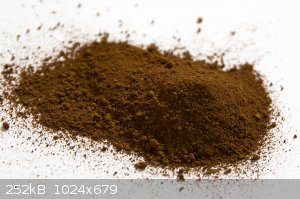
Regarding the dissociation of the soluble sulfate, I don't know why it dissociates if this isn't described in earlier articles. I didn't observe it
the first time, maybe I missed it because the solution is very dark in colour, or maybe there need to be absolutely no nucleation points for
crystallization or depends on impurities, I just don't know other than that there seems indeed a minimal concentration of SA for which the isopicramic
stays in solution. There remains a lot to be determined regarding these compounds and I've only attempted the diazotization via the sulfate once, so
everything is possible. 
[Edited on 18-6-2015 by nitro-genes]
|
|
|
Rosco Bodine
Banned
Posts: 6370
Registered: 29-9-2004
Member Is Offline
Mood: analytical
|
|
Quote: Originally posted by Hennig Brand  | | That data sheet doesn't inspire a lot of confidence does it. It is definitely more of a yellow/brown at low pH and then when enough base is added it
goes a pink/reddish color. |
There not being good data already found in the literature is no problem for us since "the book" that is reliable is being written here in this thread.
That sort of buggered data sheet from a "trusted source" being shredded here is long overdue.
Not meaning to over state the obvious but trying to keep this straight in my own mind .....thinking out loud
It will be a little fun charting the 2 likely pH transitions for a dipolar amphoteric compound like this isopicramic acid pH indicator dye. But there
are other examples known and what is probable is 2 color transition ranges will occur. There will be one color transition that is likely more intense
and abrupt for the decomposition point of a soluble picramate salt. And there may be also a second color transition at an extreme low pH where the
second polar effect and amphoterism manifests by transition of the free isopicramic acid to the isopicramic acid sulfate. Perhaps the "true"
isolelectric point is midway between those 2 color transition pH values.
The color transition that occurs at the lower pH will effectively be the "hydrolysis indicator" point for the decomposition of the soluble isopicramic
sulfate to free isopicramic acid. Below that pH is good for keeping a stable solution, and above that pH precipitation of the low soluble free
isopicramic acid will occur across the range of pH until it reaches the higher pH of the transition range for the formation of a soluble picramate
salt, and then an abrupt more intense "indication color shift" occurs there.
[Edited on 6/18/2015 by Rosco Bodine]
|
|
|
Hennig Brand
International Hazard
    
Posts: 1284
Registered: 7-6-2009
Member Is Offline
Mood: No Mood
|
|
Quote: Originally posted by nitro-genes  | The purplisch colour is from the ammonium isopicramate. I know because I tried to recrystallize the ammonium salt to obtain very pure isopicramic
once. It forms beautiful purple crystals with a green/gold lustre when dry, I suspect it is a hydrate. Likely, your iso-picramic is brown due to
presence of the ammonium salt from over neutralizing, which could also trouble the diazotization. I have been busy and not updated this into the rough
synthesis posted earlier, but during neutralization of the isopicramic sulfate it is better to aim for a pH of around 4, like I U2Ud you.  I used test strips for that, since I don't have a pH meter. I used test strips for that, since I don't have a pH meter.
|
I did see that U2U, but at the same time I read some posts that indicated simply going by color change should get me in the ball park for the correct
pH and I wanted to test it out a little. What actually happened in my case, even though I added the ammonia solution slowly over the course of 30
minutes or so from a pipette, was the color change was very slow to happen and then even after addition was stopped continued far into the ammonium
salt region. There appeared to be a lot of lag time.
"A risk-free world is a very dull world, one from which we are apt to learn little of consequence." -Geerat Vermeij
|
|
|
Rosco Bodine
Banned
Posts: 6370
Registered: 29-9-2004
Member Is Offline
Mood: analytical
|
|
When some good solubility data is available for all the materials being manipulated it will be helpful as a starting point, even though there will be
variation for the cosolublilty in "system" mixtures where more than just one material is dissolved. Some rough solubility ideas can be gotten at
points in these manipulations where losses aren't much a concern for dilutions.
On the inky darkly dyed opaque solutions if a scrap of white teflon sheet like a stirrer paddle is dropped into the beaker or held close to the inside
so a thin layer of liquid is observed against the white background in bright light, it can be seen if there are undissolved solids. Likewise if you
do a spot test and pipet out about a half ml sample and drop it on a white salad plate so it spreads out in a thin layer it can be a spot test to see
if the dark solution has everything in solution, or has solids content. A little rough "chromatography" spot test dilution to inspect any particles
may show what is the solid material.
The original solubility data from Dabney I suppose is the starting point for neat solutions of isopicramic acid.
[Edited on 6/18/2015 by Rosco Bodine]
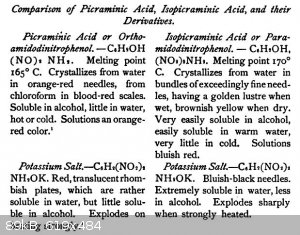
|
|
|
nitro-genes
International Hazard
    
Posts: 1048
Registered: 5-4-2005
Member Is Offline
|
|
Sure, there are probably many optimizations possible, so alternatives are always welcome. Anyway, last time I did another 20 gram acetaminophen
nitration, only this time I didn't directly go for deacetlylation. The total amount was filtered and washed 3 times using cold water, total yield was
24.3 grams and another 2.4 grams from neutralization of the first filtrate using dilute household ammonia, although the filtrate still had a lot of
colour. I noticed that even with thorough washings, a slight smell of acetic acid for the DNAc remains.
One way to get an total estimate of the yield of nitration is to determine the solubility of the ammonium salt at fridge temperature and calculate the
likely remaining ammonium salt from the volume of the filtrate (although solubility is likely affected by all the salts present after neutralization.
Alternatively, at near neutral pH, the solution may be boiled down (without to much decomposition) to 1/4 th of its original volume to precipitate
everything. Another option would be to neutralize the nitration mix carefully with a very concentrated ammonia or NaOH solution, but I neither have
the first, nor want to waste a good deal of perfectly good NaOH to squeeze out 10-20% higher yields.
Just for the fun of it, I added 3.5 g sodium nitrite to 2.5 grams of DNAc in 15 ml 10% acetic acid. The colour seems to slowly go to a deeper
orange/red, so something seems to be happening (if it is not the colour of the sodium salt) but it is still reacting so I'll post more later.
[Edited on 18-6-2015 by nitro-genes]
|
|
|
| Pages:
1
..
15
16
17
18
19
..
33 |